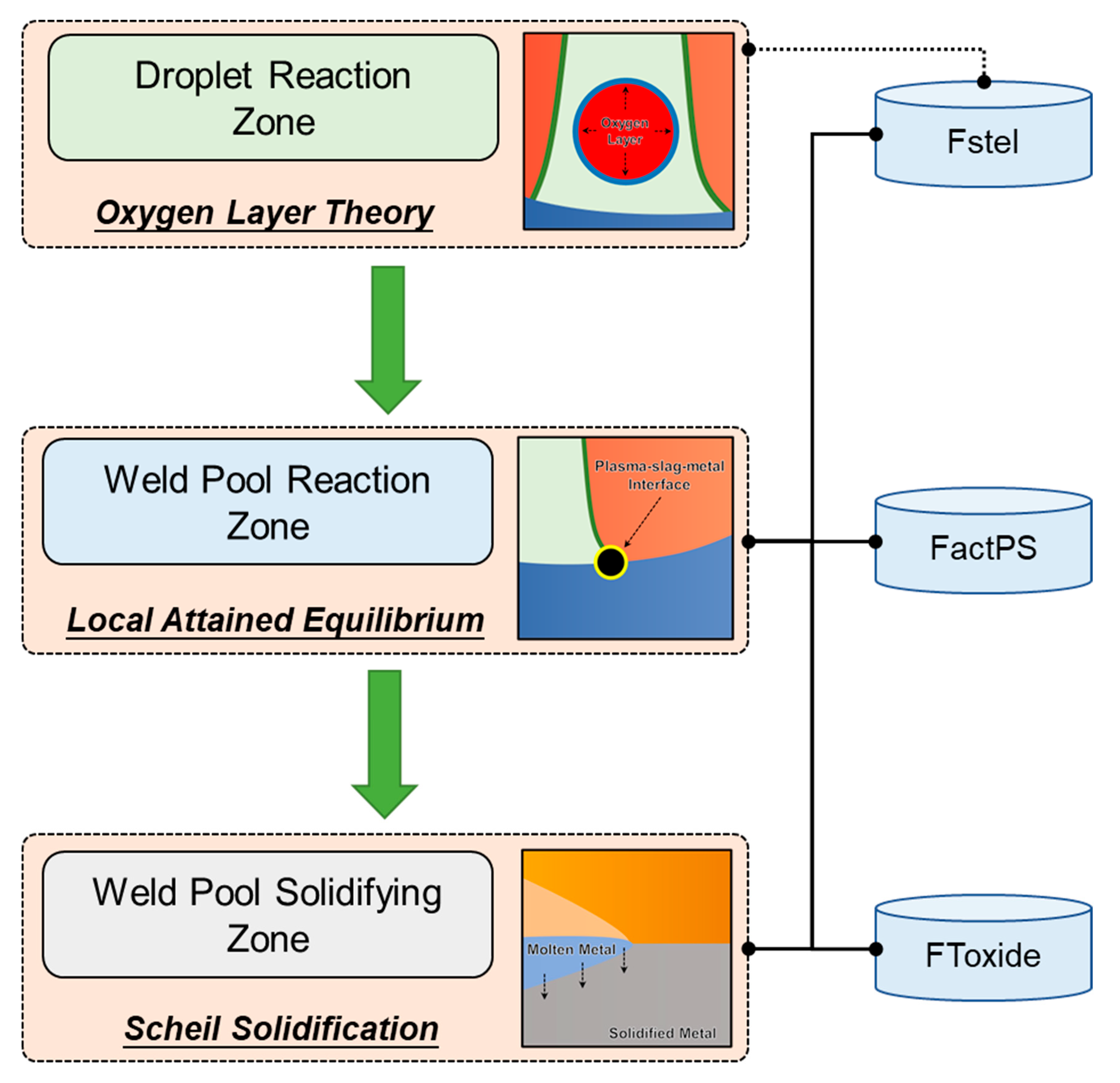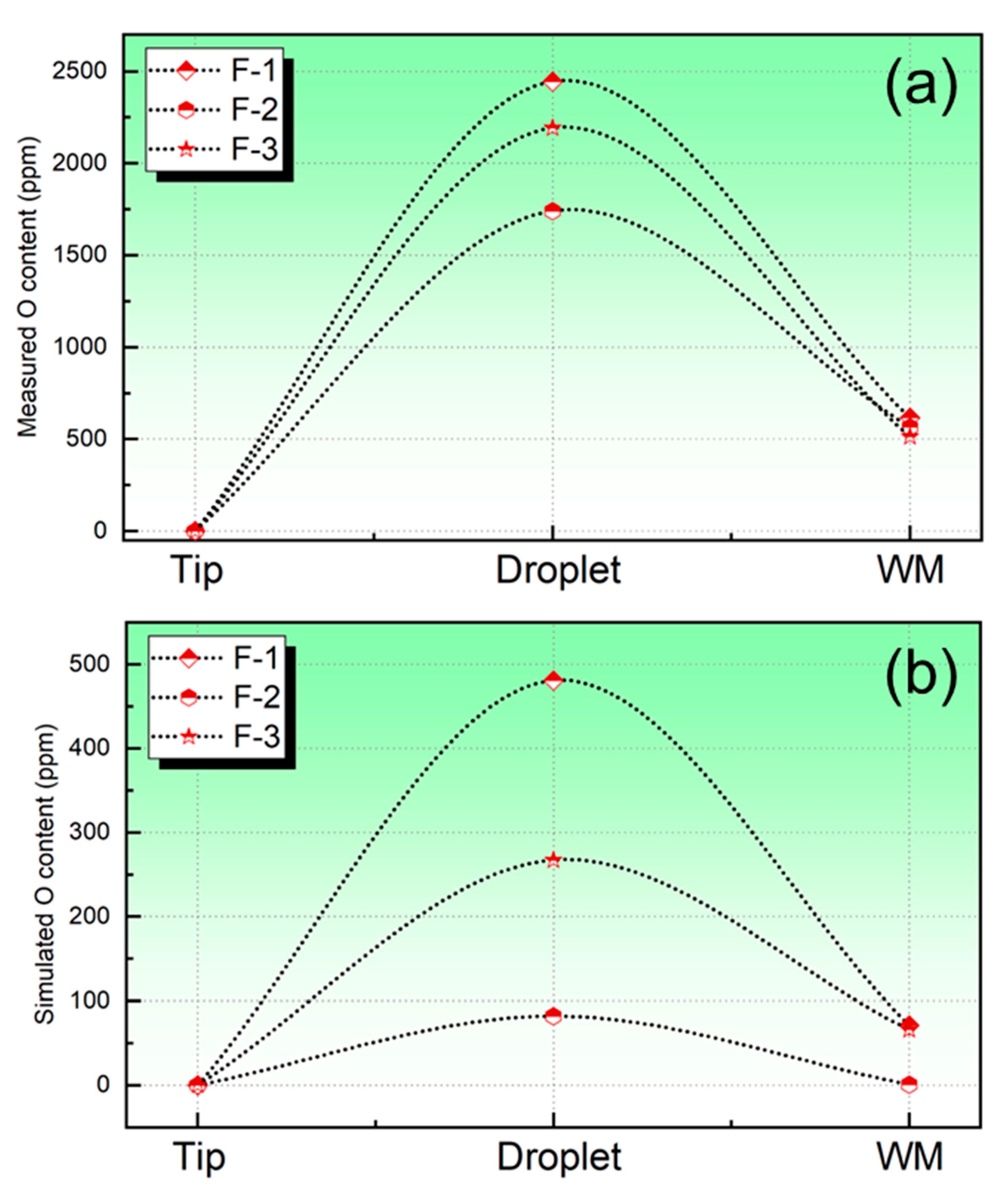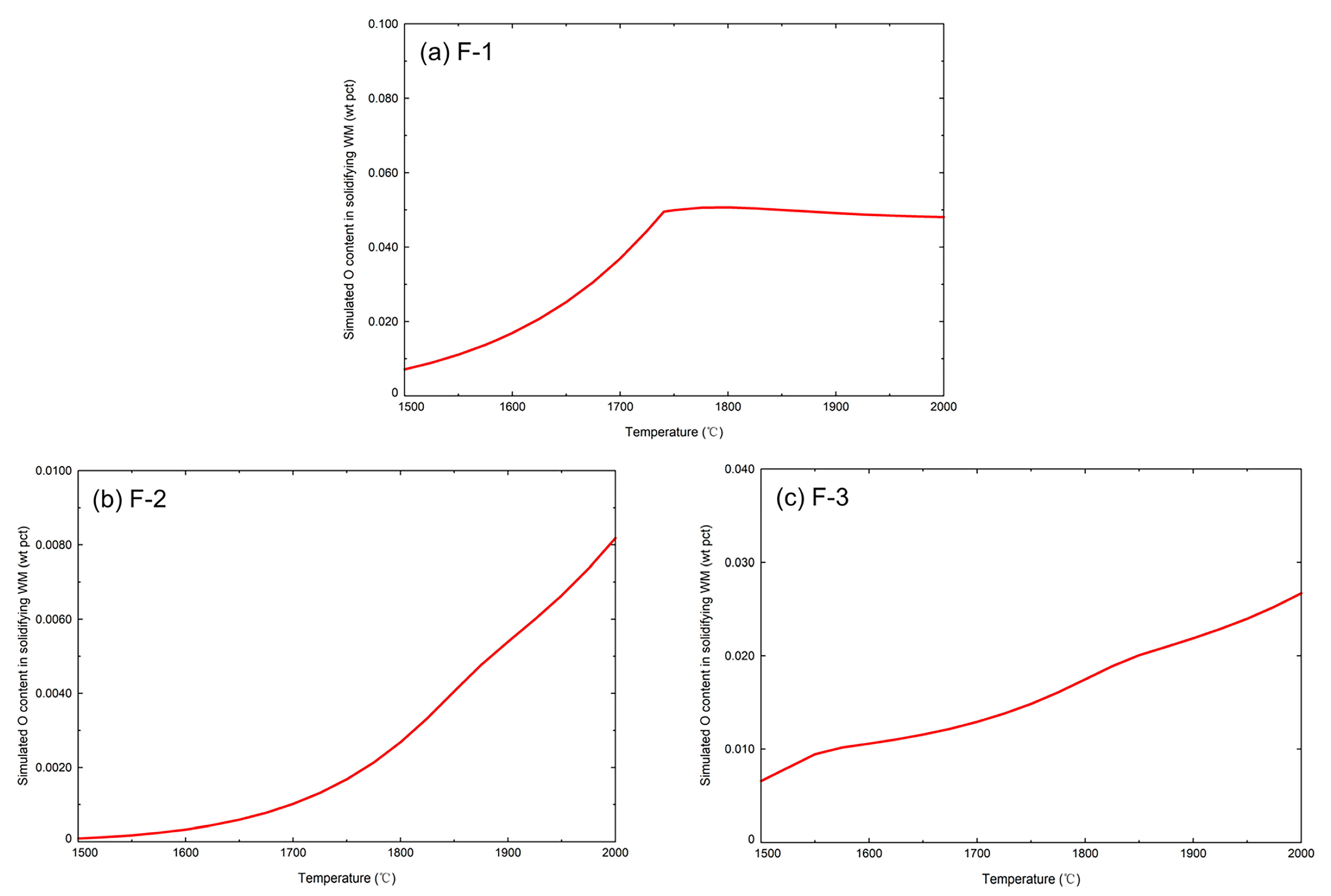Thermodynamic Simulation of O Content Variation Roadmap in Submerged Arc Welding Process: From Droplet to Weld Metal
Abstract
:1. Introduction
- The O contents in the droplet, weld pool and solidified meta have been fully considered via the Calphad technique using a reasonable scientific hypothesis of the thermodynamics in SAW.
- Attempts are made to simulate the O content variation roadmap in the overall SAW process.
- To clarify the scientific assumptions raised previously [16], the thermodynamic factors pertinent to the O content in metal at various stages in the SAW process are to be interpreted by analyzing the measured and simulated data.
- To evaluate the capabilities, as well as to clarify the limitations of the models developed by the Calphad technique.
- To identify and address issues to further improve the prediction accuracy of the models.
2. Thermodynamic Modeling
2.1. Droplet Reaction Zone
2.2. Weld Pool Reaction Zone
2.3. Weld Pool Solidifying Zone
2.4. Data Source and Simulation Tools
2.4.1. Data Source
2.4.2. Simulation Tools
3. Simulation and Discussion
3.1. Droplet Zone
- FToxid, Fstel, and FactPS databases were selected. Solution phases of ASlag-liq all oxides, S (FToxid-SLAGA), and LIQUID (FStel-Liqu) were selected to model the molten slag and steel phases.
- The equilibrium temperature in SAW was set at 2500 °C (temperature of the arc plasma).
- Based on the Oxygen Layer Theory, the equilibrium calculation with Fe and O as input metal components were performed to simulate the O concentration in the droplet since the transfer of alloying elements is hindered by the oxygen layer.
3.2. Weld Pool Reaction and Solidifying Zones
- FToxid, Fstel, and FactPS databases were selected. Solution phases of ASlag-liq all oxides, S (FToxid-SLAGA), and LIQUID (FStel-Liqu) were selected to simulate the molten slag and steel.
- The equilibrium temperature in SAW was set at 2000 °C (the assumed gas–slag–metal equilibrium temperature).
- Scheil Cooling Model was applied to simulate O content in WM during the solidifying process with FSstel-Liqu as the target phase [27].
- The output of the model of O content, coupled with the measured one, is given in Table 4.
3.3. Evaluation of O Content Variation
- It is impossible to determine the gas compositions in the arc cavity since it is shielded under the granular flux and molten slag.
- Since the molten slag and weld pool are shielded under the granular flux, it is impossible to sample the molten slag or hot metal at a high-temperature state during welding.
3.4. Evaluation of Gas Formation
- Decomposition behaviors of SiO2 and MnO in the arc cavity can be predicted, as shown by the fugacity value of SiO, Mn, and O2 gases.
- It is well-known that the evaporation of Mn tends to occur at the plasma-metal interface, during the arc welding process. It is seen from Table 5 that such evaporation behavior can be forecast, that is, significant fugacity for Mn gas is observed, even when MnO-free is employed (Flux F-2).
- Chai et al. [11] assumed that MgO decomposition is possible due to high vapor pressure of Mg, which can be reflected by the simulated composition of Mg(g) for MgO-containing flux (Flux F-2).
4. Concluding Remarks and Further Research
- By using Calphad technology, the prediction for an O content variation roadmap in the SAW process is feasible, based upon the Oxygen Layer Theory, Local Attained Equilibrium, and Scheil Solidification.
- In both Droplet and Weld Pool Reaction Zones, the level of equilibrium PO2 plays a vital role in the control for flux O potential.
- The gas formation, especially in terms of the oxide decomposition mechanisms at the plasma-flux(slag) interface, can be constrained via the proposed models.
- The physical factor, especially the entrapment of oxides should be considered.
- The kinetic models in terms of O transfer, in the overall SAW process, are needed to compensate for the bias between equilibrium and real states.
Author Contributions
Funding
Conflicts of Interest
References
- Zhang, J.; Wang, L. Upgrading the prediction model for Mn content in submerged arc welded metal via CALPHAD technology: Case study into typical acidic and basic fluxes. Ceram. Int. 2022, 49, 6573–6579. [Google Scholar] [CrossRef]
- Olson, D.; Liu, S.; Frost, R.; Edwards, G.; Fleming, D. ASM Handbook: Nature and Behavior of Fluxes Used for Welding; ASM International: Almere, The Netherlands, 1993; Volume 6A, pp. 55–63. [Google Scholar] [CrossRef]
- Mitra, U.; Eagar, T. Slag-metal Reactions during Welding: Part I. Evaluation and Reassessment of Existing Theories. Metall. Trans. B 1991, 22, 65–71. [Google Scholar] [CrossRef]
- Zhang, J.; Shao, G.; Guo, Y.; Xu, Q.; Liu, Z. Facilitating Flux Design Process Geared Towards Submerged Arc Welding via Thermodynamic Approach: Case Study into CaF2–SiO2–Na2O–Al2O3–TiO2 Agglomerated Flux. Calphad 2022, 79, 102483. [Google Scholar] [CrossRef]
- Sengupta, V.; Havrylov, D.; Mendez, P. Physical Phenomena in the Weld Zone of Submerged Arc Welding-A Review. Weld. J. 2019, 98, 283–313. [Google Scholar] [CrossRef]
- Indacochea, J.; Olson, D. Relationship of Weld-metal Microstructure and Penetration to Weld-metal Oxygen Content. J. Mater. Energy Syst. 1983, 5, 139–148. [Google Scholar] [CrossRef]
- Fox, A.; Eakes, M.; Franke, G. The Effect of Small Changes in Flux Basicity on the Acicular Ferrite Content and Mechanical Properties of Submerged Arc Weld Metal of Navy HY-100 Steel. Weld. J. 1996, 75, 330–333. [Google Scholar]
- Chaveriat, P.; Kim, G.; Shah, S.; Indacochea, J. Low Carbon Steel Weld Metal Microstructures: The Role of Oxygen and Manganese. J. Mater. Eng. 1987, 9, 253–267. [Google Scholar] [CrossRef]
- Lau, T.; Weatherly, G.; McLean, A. The Sources of Oxygen and Nitrogen Contamination in Submerged Arc Welding using CaO-Al2O3 Based Fluxes. Weld. J. 1985, 64, 343–347. [Google Scholar]
- Eagar, T. Sources of Weld Metal Oxygen Contamination during Submerged Arc Welding. Weld. J. 1978, 57, 76–80. [Google Scholar]
- Chai, C.; Eagar, T. Slag Metal Reactions in Binary CaF2-Metal Oxide Welding Fluxes. Weld. J. 1982, 61, 229–232. [Google Scholar]
- Dallam, C.; Liu, S.; Olson, D. Flux Composition Dependence of Microstructure and Toughness of Submerged Arc HSLA Weldments. Weld. J. 1985, 64, 140–151. [Google Scholar]
- Zhang, D.; Zhang, J.; Yang, S.; Shao, G.; Liu, Z. Element Transfer Behavior for CaF2-Na2O-SiO2 Agglomerated Flux Subject in Submerged Arc Welding Process. Processes 2022, 10, 1847. [Google Scholar] [CrossRef]
- Zhang, J.; Xu, Q. Probing Element Transfer Behavior during the Submerged Arc Welding Process for CaF2-SiO2-Na2O-Cr2O3 Agglomerated Fluxes: A Thermodynamic Approach. Processes 2022, 10, 1900. [Google Scholar] [CrossRef]
- Zhang, J.; Shao, G.; Fan, J.; Wang, L.; Zhang, D. A Review on Parallel Development of Flux Design and Thermodynamics Subject to Submerged Arc Welding. Processes 2022, 10, 2305. [Google Scholar] [CrossRef]
- Lau, T.; Weatherly, G.; McLean, A. Gas/metal/slag Reactions in Submerged Arc Welding Using CaO-Al2O3 Based Fluxes. Weld. J. 1986, 65, 31–38. [Google Scholar]
- Natalie, C.A.; Olson, D.L.; Blander, M. Physical and Chemical Behavior of Welding Fluxes. Annu. Rev. Mater. Sci. 1986, 16, 389–413. [Google Scholar] [CrossRef]
- Chai, C.; Eagar, T. Slag-metal Equilibrium during Submerged Arc Welding. Metall. Trans. B 1981, 12, 539–547. [Google Scholar] [CrossRef]
- Zhang, J.; Peng, L.; Zhou, L.; Chen, Y. On the Si Content Prediction for Submerged Arc Welded Metal via Calphad Technique: A Brief Discussion. J. Mater. Res. Technol. 2022, 21, 1856–1862. [Google Scholar] [CrossRef]
- Mitra, U.; Eagar, T. Slag-metal Reactions During Welding: Part II. Theory. Metall. Trans. B 1991, 22, 73–81. [Google Scholar] [CrossRef]
- Indacochea, J.E.; Blander, M.; Christensen, N.; Olson, D.L. Chemical Reactions During Submerged Arc Welding with FeO-MnO-SiO2 Fluxes. Metall. Trans. B 1985, 16, 237–245. [Google Scholar] [CrossRef]
- Mitra, U. Kinetics of slag metal reactions during submerged arc welding of steel. Ph.D. Thesis, Massachusetts Institute of Technology, Cambridge, MA, USA, 1984. [Google Scholar]
- Mitra, U.; Eagar, T. Slag-metal Reactions during Welding: Part III. Verification of the Theory. Metall. Trans. B 1991, 22, 83–100. [Google Scholar] [CrossRef]
- Kou, S. Welding Metallurgy, 3rd ed.; John Wiley & Sons, Inc.: Hoboken, NJ, USA, 2003; pp. 22–122. [Google Scholar]
- Bhadeshia, H.; Svensson, L.-E. The Microstructure of Submerged Arc-weld Deposits for High-strength Steels. J. Mater. Sci. 1989, 24, 3180–3188. [Google Scholar] [CrossRef]
- Bale, C.W.; Chartrand, P.; Degterov, S.; Eriksson, G.; Hack, K.; Mahfoud, R.B.; Melançon, J.; Pelton, A.; Petersen, S. FactSage Thermochemical Software and Databases. Calphad 2002, 26, 189–228. [Google Scholar] [CrossRef]
- Jung, I.-H. Overview of the Applications of Thermodynamic Databases to Steelmaking Processes. Calphad 2010, 34, 332–362. [Google Scholar] [CrossRef]
- Zhang, J.; Zhang, D.; Liu, P. Thermodynamic Nature of SiO2 and FeO in Flux O Potential Control Subject to Submerged Arc Welding Process. Processes 2023, 11, 400. [Google Scholar] [CrossRef]
- Bale, C.W.; Bélisle, E.; Chartrand, P.; Decterov, S.; Eriksson, G.; Gheribi, A.; Hack, K.; Jung, I.-H.; Kang, Y.-B.; Melançon, J. Reprint of: FactSage Thermochemical Software and Databases, 2010–2016. Calphad 2016, 55, 1–19. [Google Scholar] [CrossRef]
- Zhang, D.; Shao, G.; Zhang, J.; Liu, Z. On the Moving of Neutral Point for Mn Subject to Submerged Arc Welding under Various Heat Inputs: Case Study into CaF2-SiO2-Na2O-MnO Agglomerated Fluxes. Processes 2022, 10, 1888. [Google Scholar] [CrossRef]
- Burck, P.; Indacochea, J.; Olson, D. Effects of Welding Flux Additions on 4340 Steel Weld Metal Composition. Weld. J. 1990, 3, 115–122. [Google Scholar]
- Shao, G.; Liu, Z.; Fan, J.; Guo, Y.; Xu, Q.; Zhang, J. Evaluation of Flux Basicity Concept Geared toward Estimation for Oxygen Content in Submerged Arc Welded Metal. Metals 2022, 12, 1530. [Google Scholar] [CrossRef]
- Jindal, S.; Chhibber, R.; Mehta, N.P. Prediction of Element Transfer Due to Flux and Optimization of Chemical Composition and Mechanical Properties in High-strength Low-alloy Steel Weld. Proc. Inst. Mech. Eng. Part B 2015, 229, 785–801. [Google Scholar] [CrossRef]
- Kanjilal, P.; Pal, T.; Majumdar, S. Prediction of element transfer in submerged arc welding. Weld. J. 2007, 10, 40. [Google Scholar]
- Davis, M.; Bailey, N. Evidence from inclusion chemistry of element transfer during submerged arc welding. Weld. J. 1991, 70, 57–61. [Google Scholar]





| Flux | CaO | Al2O3 | MnO | SiO2 | MgO |
|---|---|---|---|---|---|
| F-1 | 42.3 | 32.4 | 25.3 | 0 | 0 |
| F-2 | 37.1 | 32.0 | 0 | 24.7 | 6.2 |
| F-3 | 39.8 | 36.5 | 13.0 | 10.6 | 0 |
| C | Mn | Si | Mo | Cr | Al | O | |
|---|---|---|---|---|---|---|---|
| Electrode | 0.11 | 1.06 | 0.27 | - | - | 0.01 | - |
| BM | 0.07 | 1.79 | 0.23 | 0.14 | 0.21 | 0.02 | 0.004 |
| Flux | PO2 | O |
|---|---|---|
| F-1 | 4.18 × 1007 | 850 |
| F-2 | 2.15 × 1007 | 610 |
| F-3 | 3.06 × 1007 | 728 |
| Flux | Measured O Content in Droplet | Simulated O Content in Droplet | Measured O Content in WM | Simulated O Content in WM |
|---|---|---|---|---|
| F-1 | 2445 | 850 | 616 | 481 |
| F-2 | 1740 | 610 | 565 | 82 |
| F-3 | 2192 | 728 | 513 | 267 |
| Flux | F-1 | F-2 | F-3 |
|---|---|---|---|
| Mn | 4.98 × 10−1 | 7.31 × 10−2 | 2.69 × 10−1 |
| Al | 2.42 × 10−4 | 5.88 × 10−4 | 4.69 × 10−4 |
| Al2O | 2.30 × 10−5 | 9.73 × 10−5 | 7.39 × 10−5 |
| AlO | 3.12 × 10−5 | 5.44 × 10−5 | 5.18 × 10−5 |
| O | 3.14 × 10−5 | 2.25 × 10−5 | 2.68 × 10−5 |
| SiO | 6.90 × 10−4 | 1.53 × 10−1 | 3.53 × 10−2 |
| Mg | 0 | 7.31 × 10−2 | 0 |
| O2 | 4.18 × 10−7 | 2.15 × 10−7 | 3.06 × 10−7 |
Disclaimer/Publisher’s Note: The statements, opinions and data contained in all publications are solely those of the individual author(s) and contributor(s) and not of MDPI and/or the editor(s). MDPI and/or the editor(s) disclaim responsibility for any injury to people or property resulting from any ideas, methods, instructions or products referred to in the content. |
© 2023 by the authors. Licensee MDPI, Basel, Switzerland. This article is an open access article distributed under the terms and conditions of the Creative Commons Attribution (CC BY) license (https://creativecommons.org/licenses/by/4.0/).
Share and Cite
Zhang, J.; Zhang, D. Thermodynamic Simulation of O Content Variation Roadmap in Submerged Arc Welding Process: From Droplet to Weld Metal. Processes 2023, 11, 784. https://doi.org/10.3390/pr11030784
Zhang J, Zhang D. Thermodynamic Simulation of O Content Variation Roadmap in Submerged Arc Welding Process: From Droplet to Weld Metal. Processes. 2023; 11(3):784. https://doi.org/10.3390/pr11030784
Chicago/Turabian StyleZhang, Jin, and Dan Zhang. 2023. "Thermodynamic Simulation of O Content Variation Roadmap in Submerged Arc Welding Process: From Droplet to Weld Metal" Processes 11, no. 3: 784. https://doi.org/10.3390/pr11030784
APA StyleZhang, J., & Zhang, D. (2023). Thermodynamic Simulation of O Content Variation Roadmap in Submerged Arc Welding Process: From Droplet to Weld Metal. Processes, 11(3), 784. https://doi.org/10.3390/pr11030784







